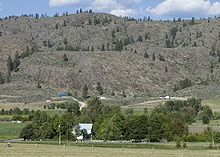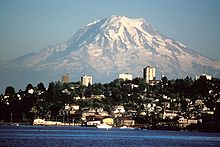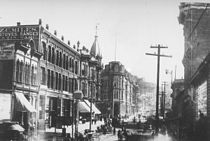Washington (state)
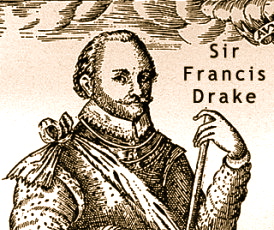
Washington State History
Timeline of Washington (state): 1500’s – 1700’s
- (1543) Spain claimed Pacific Northwest
- (1579) Sir Francis Drake claimed Washington coast for England
 (1592) Juan de Fuca discovered Strait of Juan de Fuca
(1592) Juan de Fuca discovered Strait of Juan de Fuca- (1774) Juan Perez led first Spanish expedition to Northwest Coast, discovered Olympic Mountains
- (1775) Bruno de Hezeta landed on Washington coast, claimed area for Spain
- (1778) James Cook explored and charted the Northwest Coast
- (1792) George Vancouver explored and named Puget Sound; Spain established first non-Indian settlement in Washington at Neah Bay
1800’s
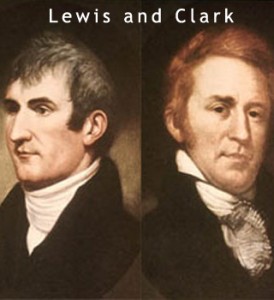 (1805-1806) Lewis and Clark reached Washington
(1805-1806) Lewis and Clark reached Washington- (1811) John Jacob Astor built Fort Astoria, part of Pacific Fur Company at Columbia River mouth
- (1825) Forts Vancouver and Colvile established on Columbia River by Hudson Bay Company
- (1841) Charles Wilkes led United States naval expedition to explore Washington
- (1842) John C. Fremont witnessed eruption of Mount St. Helens
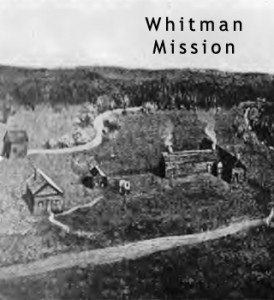 (1847) Cayuse Indians attacked Whitman Mission in Walla Walla
(1847) Cayuse Indians attacked Whitman Mission in Walla Walla- (1851) First settlers arrived at Seattle site
- (1853) Washington Territory created.
- (1855-58) Yakima Indian Wars occurred
- (1858) Cascade Railroad Company began operating in Columbia River Gorge; Indian wars ended
- (1860) Gold and silver discovered in Okanogan
- 1886 Coal mining town of Roslyn founded
- 1889 Washington became 42nd state
- (1897-99) Klondike Gold Rush brought thousands to Seattle
- (1899) Mount Rainier National Park established
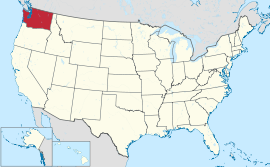 Washington (
Washington (![]() i/ˈwɒʃɪŋtən/) is a state in the Pacific Northwest region of the United States located north of Oregon, west of Idaho and south of the Canadian province ofBritish Columbia, on the coast of the Pacific Ocean. Washington was carved out of the western part of Washington Territory which had been ceded by Britain in 1846 by the Oregon Treaty as settlement of the Oregon Boundary Dispute. It was admitted to the Union as the 42nd state in 1889.
i/ˈwɒʃɪŋtən/) is a state in the Pacific Northwest region of the United States located north of Oregon, west of Idaho and south of the Canadian province ofBritish Columbia, on the coast of the Pacific Ocean. Washington was carved out of the western part of Washington Territory which had been ceded by Britain in 1846 by the Oregon Treaty as settlement of the Oregon Boundary Dispute. It was admitted to the Union as the 42nd state in 1889.
Washington is the 18th most extensive and the 13th most populous of the 50 United States. Approximately 60 percent of Washington’s residents live in the Seattle metropolitan area, the center of transportation, business, and industry along the Puget Sound region of the Salish Sea, an inlet of the Pacific consisting of numerous islands, deep fjords, and bays carved out by glaciers. The remainder of the state consists of deep rainforests in the west, mountain ranges in the west, center, northeast and far southeast, and a semi-arid eastern basin given over to intensive agriculture. Washington is the second most populous state on the west coast and in the western United States after California.
Early History
A farm and barren hills near Riverside, in northeastern Washington.
The skeletal remains of Kennewick Man, one of the oldest and most complete human remains ever found in North America, were discovered in Washington. Prior to the arrival of explorers from Europe, the region had many established tribes of Native Americans, notable for their totem poles and their ornately carved canoes and masks. Prominent among their industries were salmon fishing and, notably among the Makah, whale hunting. The peoples of the Interior had a very different subsistence-based culture based on hunting, food-gathering and some forms of agriculture, as well as a dependency on salmon from the Columbia and its tributaries. The smallpox epidemic of the 1770s devastated the native american population.
European exploration
Mount Rainier with Tacoma in foreground
The first recorded European landing on the Washington coast was by Spanish Captain Don Bruno de Heceta in 1775, on board the Santiago, part of a two-ship flotilla with the Sonora. He claimed all the coastal lands up to Prince William Sound for Spain as part of their claimed rights under the Treaty of Tordesillas, which they maintained made the Pacific a “Spanish lake” and all its shores part of the Spanish Empire.
In 1778, British explorer Captain James Cook sighted Cape Flattery, at the entrance to the Strait of Juan de Fuca, but Cook did not realize the strait existed. It was not discovered until Charles William Barkley, captain of the Imperial Eagle, sighted it in 1787. The straits were further explored by Spanish explorers Manuel Quimper in 1790 and Francisco de Eliza in 1791, and British explorer George Vancouver in 1792.
Settlement
The British-Spanish Nootka Convention of 1790 ended Spanish claims of exclusivity and opened the Northwest Coast to explorers and traders from other nations, most notably Britain and Russia as well as the fledgling United States. American captain Robert Gray (for whom Grays Harbor County is named) then discovered the mouth of the Columbia River. He named the river after his ship, theColumbia. Beginning in 1792, Gray established trade in sea otter pelts. The Lewis and Clark Expedition entered the state on October 10, 1805.
Explorer David Thompson, on his voyage down the Columbia River camped at the junction with the Snake River on July 9, 1811 and erected a pole and a notice claiming the country for Great Britain and stating the intention of the North West Company to build a trading post at the site.
Britain and the United States agreed to what has since been described as “joint occupancy” of lands west of the Continental Divide to the Pacific Ocean as part of the Anglo-American Convention of 1818, which established the 49th Parallel as the international boundary west from Lake of the Woods to the Rocky Mountains. Resolution of the territorial and treaty issues, west to the Pacific, were deferred until a later time. Spain, in 1819, ceded their rights north of the 42nd Parallel to the United States, although these rights did not include possession.
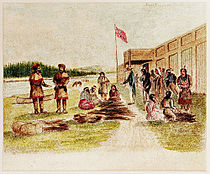 Fur trading at Fort Nez Percés in 1841
Fur trading at Fort Nez Percés in 1841
Negotiations with Great Britain over the next few decades failed to settle upon a compromise boundary and the Oregon boundary dispute was highly contested between Britain and the United States. Disputed joint-occupancy by Britain and the U.S. lasted for several decades. With American settlers pouring into Oregon Country, Hudson’s Bay Company, which had previously discouraged settlement because it conflicted with the fur trade, reversed its position in an attempt to maintain British control of the Columbia District. Fur trapper James Sinclair, on orders from Sir George Simpson, Governor of the Hudson’s Bay Company, led some 200 settlers from the Red River Colony west in 1841 to settle on Hudson Bay Company farms near Fort Vancouver. The party crossed the Rockies into the Columbia Valley, near present-day Radium Hot Springs, British Columbia, then traveled south-west down the Kootenai River and Columbia River. Despite such efforts, Britain eventually ceded all claims to land south of the 49th parallel to the United States in the Oregon Treaty on June 15, 1846.
In 1836, a group of missionaries including Marcus Whitman established several missions and Whitman’s own settlement Waiilatpu, in what is now southeastern Washington state, near present day Walla Walla County, in territory of both the Cayuse and the Nez Perce Indian tribes. Whitman’s settlement would in 1843 help the Oregon Trail, the overland emigration route to the west, get established for thousands of emigrants in following decades. Marcus provided medical care for the Native Americans, but when Indian patients – lacking immunity to new, ‘European’ diseases – died in striking numbers, while at the same time many white patients recovered, they held ‘medicine man’ Marcus Whitman personally responsible, and murdered Whitman and twelve other white settlers in the Whitman massacre in 1847. This event triggered the Cayuse War between settlers and Indians.
Fort Nisqually, a farm and trading post of the Hudson’s Bay Company and the first European settlement in the Puget Sound area, was founded in 1833. Black pioneer George Washington Bush and his caucasian wife, Isabella James Bush, from Missouri and Tennessee, respectively, led four white families into the territory and founded New Market, now Tumwater, in 1846. They settled in Washington to avoid Oregon’s discriminatory settlement laws. After them, many more settlers, migrating overland along the Oregon trail, wandered north to settle in the Puget Sound area.
Statehood
In 1852, people from all over what was to become Washington state gathered in Monticello (now Longview) to draft a memorandum to Congress. The memorandum expressed a desire to be granted statehood under the name of Columbia. This meeting came to be known as the Monticello Convention. The Convention’s requests were met favorably in Congress, but it was decided that a state named Columbia might be confused with the preexisting District of Columbia. In a manner which strangely enough did not solve the problem of being confused with the nation’s capital, the state was instead named Washington in honor of the first U.S. president. Washington became the 42nd state in the United States on November 11, 1889.
Early prominent industries in the state included agriculture and lumber. In eastern Washington, the Yakima River Valley became known for its apple orchards, while the growth of wheat using dry-farming techniques became particularly productive. Heavy rainfall to the west of the Cascade Range produced dense forests, and the ports along Puget Sound prospered from the manufacturing and shipping of lumber products, particularly the Douglas-fir. Other industries that developed in the state included fishing, salmon canning and mining.

